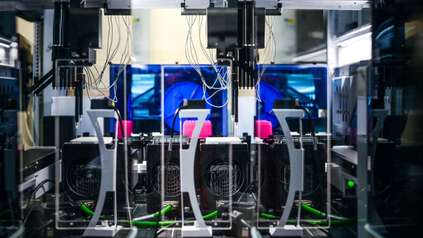New collaboration to uncover how the hidden language of genes shapes our immune system
Listen to this news story
Listen to “New collaboration to uncover how the hidden language of genes shapes our immune system” on Spreaker.
Scientists at the Wellcome Sanger Institute, in collaboration with Pacific Biosciences (PacBio), will use advanced long-read sequencing technology to profile gene expression at single-cell resolution. By applying this technology to nearly 1,500 blood and gut tissue samples from three major ongoing studies, researchers will be able to capture not only the extent to which genes are expressed but also which versions, known as isoforms, of each gene are used.
This approach will provide high-resolution maps of RNA expression and splicing across different cell types, tissues, and individuals. These insights could prove critical to gaining a complete understanding of human health conditions and reveal why some treatments work better for certain people.
This project marks a pivotal step as it is the first time that the Institute will use long-read single-cell RNA sequencing at scale. The team will analyse samples from three of the Sanger Institute’s ongoing studies. Two of these, IBDverse and IBD-Response1, aim to uncover new ways to treat IBD, a chronic inflammatory condition of the gastrointestinal tract that is estimated to affect up to 10 million people worldwide2. By sequencing cells from individuals both with and without the condition, researchers hope to identify RNA isoforms linked to IBD susceptibility, progression, and response to treatment.
The third, Project JAGUAR3, is a large-scale collaboration across seven Latin American countries that explores how genetic diversity shapes immune responses. Samples from Peru and Mexico will be analysed, bringing valuable insights into how ancestral diversity shapes isoform variation and immune responses.
The single-cell transcriptomics4 revolution has transformed our understanding of biology by showing how gene activity varies across individual cells, tissues, and health conditions. Unlike DNA sequencing, which reveals changes in the genetic code itself, RNA sequencing offers a dynamic snapshot of which genes are active and the level of activity in any given tissue sample or cell.
Until now, most large-scale efforts have relied on short-read sequencing5, which has enabled researchers at the Sanger Institute to generate detailed maps of gene expression across many thousands of samples, helping reveal which genes are switched on or off in different tissues and health conditions. However, short reads cannot fully capture the diversity of RNA isoforms, which are different versions of RNA that can come from a single gene, due to alternative splicing.
Once published, the datasets generated through this project will be made openly available to the global scientific community, providing a valuable resource to advance research in IBD and immunology. In parallel, the team will share their technical insights and develop new computational methods to support the efficient analysis of long-read single-cell RNA data. By doing so, they aim to lower barriers for other researchers and enable the wider adoption of long-read single-cell approaches across large cohorts and population biobanks.
“Project JAGUAR represents a transformative step toward globally inclusive research, bringing much-needed diversity to our understanding of immune regulation. I’m particularly excited that this new initiative will place samples from underrepresented populations, specifically from Peru and Mexico, at the forefront of this uniquely ambitious study. By exploring how ancestry shapes transcriptional complexity at single-cell resolution, we are taking an important leap forward in ensuring that insights from genomic research truly reflect the diversity of human biology.”
Dr Gosia Trynka, Group Leader at the Wellcome Sanger Institute and Science Director at Open Targets
“At PacBio, we believe the most meaningful science happens when technology serves a clear purpose. This collaboration with the Sanger Institute brings that vision to life, using HiFi long-read sequencing to uniquely capture the full isoform landscape at single-cell resolution and at scale. It is a powerful example of how accuracy and completeness can reveal new insights into immune function, IBD progression, and treatment response. Through Project JAGUAR, we’re proud to support greater representation in genomic research so that these insights translate into real benefits for communities around the world.”
Christian Henry, President and Chief Executive Officer of PacBio
“Long-read sequencing gives us the chance to look at gene activity in much greater detail than before. By applying this technology at scale, we hope to uncover biological differences that could explain why some people respond better to treatments for conditions like Inflammatory Bowel Disease than others. IBD affects many lives, and current therapies don’t work for everyone. This project could help us understand why and open new directions for more effective, personalised treatment. If successful, it could also establish a powerful approach for studying the molecular basis of many other human health conditions.”
Dr Carl Anderson, Interim Head of Human Genetics at the Wellcome Sanger Institute
More information
- The largest single-cell cohort of IBD, IBDverse aims to identify the genes, cell types, and pathways driving the development and severity of Crohn’s disease. The second set of samples is from IBD-Response, the largest study of drug responses in IBD, which hopes to understand how and why people respond differently to IBD treatment, including whether their genetics plays a role.
- EFCCA, What is IBD? Available at: https://www.efcca.org/about-ibd
- Further information about Project JAGUAR can be found here: https://www.sanger.ac.uk/collaboration/project-jaguar/
- Transcriptomics is the study of all the RNA produced by the genome. Single-cell spatial transcriptomics is the study of RNA transcripts while also analysing where the cell is in the tissue.
- Short-read genomic sequencing methods focus on specific parts of the genome and have a range of applications across research. Long-read genomic sequencing gives a complete view of the genome, which allows researchers to more easily identify and analyse different genetic variations in a sample.
Funding:
This initiative is supported by Pacific Biosciences (PacBio).





